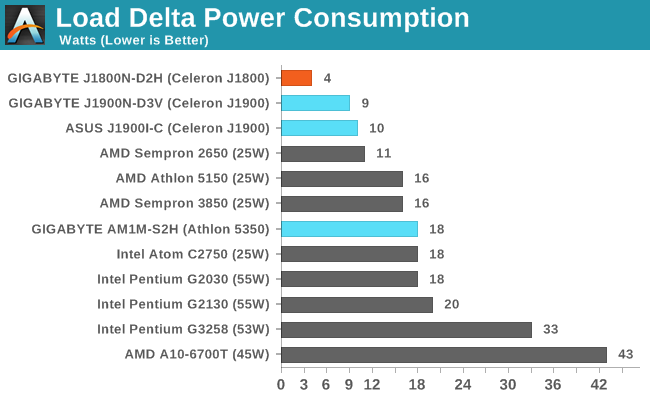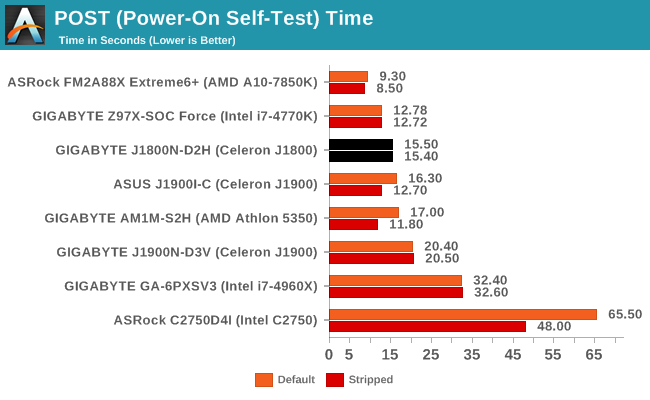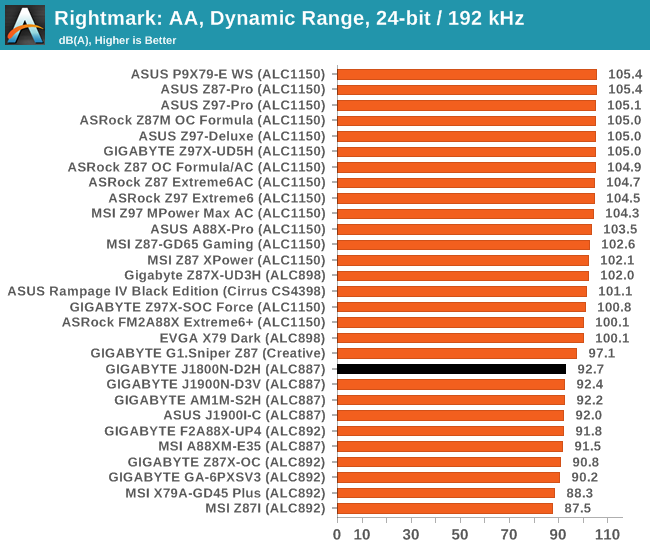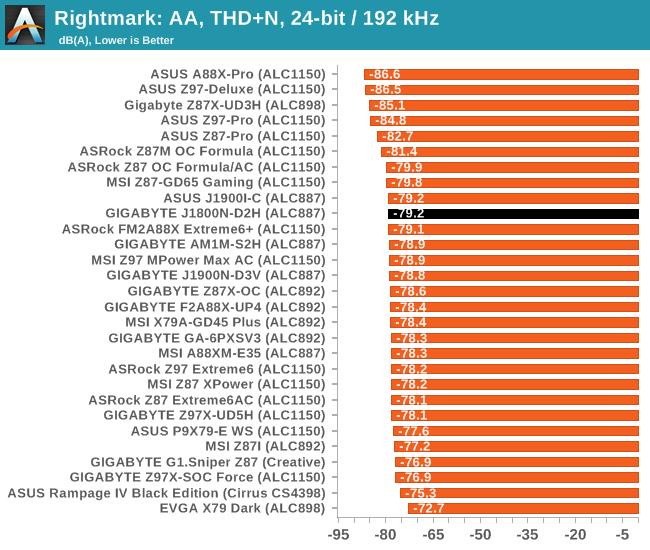GIGABYTE GA-J1800N-D2H Review: Dual Core Bay Trail-D at $69
by Ian Cutress on December 26, 2014 11:00 AM EST- Posted in
- Motherboards
- Intel
- Bay Trail
System and Motherboard Performance
Power Consumption
Power consumption was tested on the system while with a wall meter connected to the Rosewill 500W Platinum power supply. As this power supply is Platinum rated and as I am in the UK on a 230-240 V supply, this leads to ~75% efficiency > 20W, and 92%+ efficiency at 50W, suitable for both idle and multi-GPU loading. This method of power reading allows us to compare the power management of the UEFI and the board to supply components with power under load, and includes typical PSU losses due to efficiency. These are the real world values that consumers may expect from a typical system (minus the monitor) using this motherboard.
While this method for power measurement may not be ideal, and you feel these numbers are not representative due to the high wattage power supply being used, the important point to take away is the relationship between the numbers. These boards are all under the same conditions, and thus the differences between them should be easy to spot.

Despite being rated for a 10W TDP, the J1800 measures only 4W difference between idle and load. The J1900 is also rated at 10W TDP, but gives 9W/10W due to the extra cores.
Windows 7 POST Time
Different motherboards have different POST sequences before an operating system is initialized. A lot of this is dependent on the board itself, and POST boot time is determined by the controllers on board (and the sequence of how those extras are organized). As part of our testing, we look at the POST Boot Time using a stopwatch. This is the time from pressing the ON button on the computer to when Windows 7 starts loading. (We discount Windows loading as it is highly variable given Windows specific features.)

Out of the Bay Trail-D boards tested so far, the J1800N-D3H comes top for default POST times.
Rightmark Audio Analyzer 6.2.5
Rightmark:AA indicates how well the sound system is built and isolated from electrical interference (either internally or externally). For this test we connect the Line Out to the Line In using a short six inch 3.5mm to 3.5mm high-quality jack, turn the OS speaker volume to 100%, and run the Rightmark default test suite at 192 kHz, 24-bit. The OS is tuned to 192 kHz/24-bit input and output, and the Line-In volume is adjusted until we have the best RMAA value in the mini-pretest. We look specifically at the Dynamic Range of the audio codec used on board, as well as the Total Harmonic Distortion + Noise.


With all the motherboards in this test using the ALC887, there is not much to choose between them.
USB Backup
For this benchmark, we transfer a set size of files from the SSD to the USB drive using DiskBench, which monitors the time taken to transfer. The files transferred are a 1.52 GB set of 2867 files across 320 folders – 95% of these files are small typical website files, and the rest (90% of the size) are small 30 second HD videos. In an update to pre-Z87 testing, we also run MaxCPU to load up one of the threads during the test which improves general performance up to 15% by causing all the internal pathways to run at full speed.

Compared to the high end motherboards that perform our USB 2.0 tests around 42 seconds, the Bay Trail IO is relatively slow.
DPC Latency
Deferred Procedure Call latency is a way in which Windows handles interrupt servicing. In order to wait for a processor to acknowledge the request, the system will queue all interrupt requests by priority. Critical interrupts will be handled as soon as possible, whereas lesser priority requests such as audio will be further down the line. If the audio device requires data, it will have to wait until the request is processed before the buffer is filled.
If the device drivers of higher priority components in a system are poorly implemented, this can cause delays in request scheduling and process time. This can lead to an empty audio buffer and characteristic audible pauses, pops and clicks. The DPC latency checker measures how much time is taken processing DPCs from driver invocation. The lower the value will result in better audio transfer at smaller buffer sizes. Results are measured in microseconds.

Despite being motherboards with low power CPUs, the DPC latency is around the 100 microsecond mark which is a good sign.










38 Comments
View All Comments
lioncat55 - Friday, December 26, 2014 - link
When ever I see a system like this I want to build a Plex server. But it never seems like the CPU is enough.LoneWolf15 - Friday, December 26, 2014 - link
@lioncat55 - Asrock makes the Q2900-ITX , a J2900 Bay Trail quad core. You'll probably find it a little more suitable.I went Core i3-3225 at the time I built my HTPC due to the HD4000 graphics. Still working well running XBMC Gotham.
xbenny - Saturday, December 27, 2014 - link
@lioncat55 - I hear you man I'm in the same quest check out this review of Q2900-ITX @techspot http://www.techspot.com/review/882-intel-pentium-j... @LoneWolf - still not enough for on-the-fly-transcoding for Plex serverStevoLincolnite - Saturday, December 27, 2014 - link
Give it time.These chips aren't even in the same league as the Core 2 processors from 6-7 years ago in terms of performance-per-clock, but they do use a tiny fraction of the energy.
They're certainly a big step up from the old Atoms.
Might start getting competitive with Nahelem class chips in the next 3-4 years, which is when things would start to get interesting.
barleyguy - Monday, December 29, 2014 - link
You can get an AMD FX-6300 for $89, and throw it on a cheap motherboard. It works great for Plex; the 6 integer cores are surprisingly good at transcoding. I'm doing 1080p full Bluray transcoded to 20 Mbps for playback across powerline ethernet.It does use way more electricity than one of these though.
Another decent Plex server is the NVidia Jetson board. There's an accelerated Plex build for it. It's almost $200, but includes the CPU, RAM, and 16 GB of storage, so it's basically turnkey. The power usage on that is about 7 watts typical and 15 watts peak, not counting the hard drive the movies are on. (This option does require some Linux knowledge. You need to update Linux for Tegra and set up Plex server as chroot.)
$.02
KWIE - Wednesday, January 7, 2015 - link
@lioncat55 - I have a FreeNAS box with Plex Server running inside a jail on an Asrock Q1900-ITX, basically the quad core version of this, but with lower per-core frequency. There are other versions available also including one with DC-in. The above model also has 4 SATA ports (vital for me with a 4 drive ZFS setup). I boot from a Sandisk Cruzer Fit USB drive with no issues.I have one large, slow fan blowing over the drives in the entire case and never have any heat issues. Very, very happy with it... and now considering building another for a family member.
dragosmp - Friday, December 26, 2014 - link
Great review, I like the comparison with HP's Stream. To push it further I would say in this particular case it's obvious one should pick up the OEM made, but what about if someone wants a quad BT? Then for 20$ more someone can get twice the performance for 5% in system cost. It's endless reasoning, but I just wanted to point out this bitbill.rookard - Friday, December 26, 2014 - link
Agreed. I have the ASRock Q1900M (quad-core, full size DIMMs, a few more x1 slots and a full x16 (x1 wired) slot) and that allows for quite a bit more flexibility. It's still a very small board - same depth as ITX, just a little more width. The extra x1 slots could allow for some extra sata connectivity, the x16 could allow for a more powerful gpu (the intel solution onboard is marginal at best - only 4EU's).Overall though, armed with a SSD (Samsung 830) it's more than adequate for HTPC duty.
ddriver - Friday, December 26, 2014 - link
The lack of performance is otherworldly.I guess gaming benches were a logical component of the review for this product, seeing how it is definitely intended for such tasks. /sarcasm
To hell with stuff like media playback or a file server, workloads such a product is actually suited for. Who cares how this product works for stuff it is actually usable for.
Gigaplex - Friday, December 26, 2014 - link
Insufficient SATA ports for this to be used as a file server.